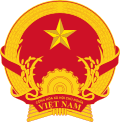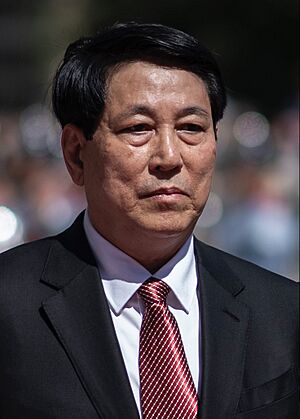President of Vietnam facts for kids
Quick facts for kids President of theSocialist Republic of Vietnam |
|
|---|---|

Emblem of Vietnam
|
|
| Style | Mr. President (informal) State President (informal) His Excellency (diplomatic) |
| Member of |
|
| Residence | Presidential Palace |
| Nominator | Standing Committee of the National Assembly |
| Appointer | National Assembly |
| Term length | Five years,
no term limits
|
| Constituting instrument | Constitution of Vietnam (2014) |
| Inaugural holder | Hồ Chí Minh |
| Formation | 2 September 1945 |
| Deputy | Vice President |
| Salary | 30,420,000₫ monthly |
The President of the Socialist Republic of Vietnam is the head of state of Vietnam. This means they are the top representative of the country. The president is chosen by the National Assembly of Vietnam, which is like Vietnam's parliament.
Since Vietnam has a one-party state, candidates for president are suggested by the Central Committee of the Communist Party of Vietnam. The president is usually seen as the second most important person in Vietnam's political system. The General Secretary of the Communist Party of Vietnam is generally considered the highest-ranking official.
The president represents Vietnam both inside the country and to other nations. They help make sure the government runs smoothly and protects Vietnam's independence and borders.
To become president, a person must be a member of the National Assembly of Vietnam. They are also usually a member of the Central Committee of the Communist Party of Vietnam and the Politburo of the Communist Party of Vietnam. The Central Committee suggests candidates to the National Assembly's Standing Committee. Then, the National Assembly officially votes for the president.
The president also chooses other important officials. These include the Vice President of Vietnam, Prime Minister of Vietnam, and government ministers. These choices need to be approved by the National Assembly. The president is also the top leader of the Vietnam People's Armed Forces. They lead the Council for National Defense and Security (Vietnam).
General Lương Cường is the current president of Vietnam. He started his role on October 21, 2024.
Contents
Understanding the President's Role
The president's power has changed over time. For example, the first president, Hồ Chí Minh, was also the leader of the Communist Party. This made him the most powerful person in Vietnam.
Later presidents, like Tôn Đức Thắng, had less power. They were more like a symbolic figure. Since Trường Chinh became president, the president has usually been the second most important person in the Politburo. The Politburo is the main decision-making group in Vietnam.
Sometimes, one person has held both the top party and state roles. This happened with Hồ Chí Minh, Trường Chinh, Nguyễn Phú Trọng, and Tô Lâm.
The president serves for five years. There are no term limits, meaning a president can serve more than once. If a president cannot do their job, the vice president steps in temporarily. The vice president acts as president until the original president returns or a new one is elected. Võ Thị Ánh Xuân has served as acting president twice. Đặng Thị Ngọc Thịnh was the first woman to be acting president in 2018.
A Look at History
How the Presidency Began
Hồ Chí Minh became Vietnam's first president in 1946. The National Assembly appointed him. The 1959 Constitution said the National Assembly could choose and remove the president. In the beginning, the president had a lot of power, similar to the president in the United States or France. They were both the head of state and the head of government.
Changes to the President's Power
The 1959 Constitution reduced the president's power. The president became the official leader, but most of the real power went to the General Secretary of the Central Committee of the Communist Party of Vietnam.
In 1980, the role of head of state changed a lot. The president's office was removed. Instead, there was a Chairman of the Council of State. This new role was similar to a position in the Soviet Union. The Council of State made decisions as a group. It worked alongside the Council of Ministers. These changes made the executive branch stronger and the legislative branch weaker.
The Council of State members were chosen by the National Assembly. The Chairman of the Council of State also led the National Defense Council and was the top leader of the armed forces. The Council of State watched over other government groups. In 1992, the office of Chairman of the Council of State was replaced by the office of President again.
The President's Importance Over Time
The importance of the president has not always been the same. For example, while Hồ Chí Minh was the top leader, his successor, Tôn Đức Thắng, had little power. The role of head of state became stronger again in 1980 with Trường Chinh. He was the second most important person in the Politburo.
The president usually kept the second-highest rank in the Politburo. However, Nguyễn Minh Triết was ranked fourth when he became president in 2006. In 2011, Trương Tấn Sang became the first-ranked member of the Politburo who was not the General Secretary or Chairman of the party. This meant he was the unofficial head of the Politburo. Decisions in the Politburo are made by group agreement.
Today, the president's role is often compared to ceremonial positions in countries like Singapore or Germany. However, the Vietnamese president still has some executive, judicial, and legislative powers. Also, because presidents are usually high-ranking members of the Politburo, they are very influential in Vietnamese politics. For example, Nguyễn Phú Trọng was president from 2018 to 2021 while also being the General Secretary, the highest position in the Communist Party.
How Long Does a President Serve?
The president is chosen for a five-year term. Their term continues until a new president is elected and takes office.
When a president starts their job, they take an oath. This oath is a promise made before the parliament:
In my capacity as President of the Socialist Republic of Vietnam, I swear complete allegiance to the country, people, and constitution; to fulfill the tasks assigned by the State, and people.
What the President Does
The president is the head of state for Vietnam. Their main job is to represent Vietnam both inside the country and to other nations. The National Assembly of Vietnam elects the president. The president is responsible to the National Assembly and reports to them.
Here are some of the president's main powers and responsibilities:
- Signs new laws, special decrees, and the country's main rulebook (the Constitution).
- Can stop decisions made by the Prime Minister of Vietnam or Deputy Prime Minister of Vietnam if they go against the Constitution or laws.
- Is the top leader of Vietnam's armed forces.
- Leads the Council for National Defense and Security (Vietnam).
- Takes steps to protect Vietnam's independence and borders.
- Makes sure all parts of the government work well together.
- Suggests who should be the Vice President of Vietnam, Prime Minister of Vietnam, and top judges to the National Assembly.
- Can lead meetings of the Government of Vietnam.
- Appoints or removes officials who work in the Office of the President.
- Appoints or removes deputy prime ministers, ministers, and other government members.
- Can declare a state of war or grant amnesty (forgiveness for crimes).
- Can order a general or partial mobilization (calling people to military service) or declare a state of emergency across the country or in a specific area. This is done based on a resolution from the National Assembly's Standing Committee.
- Appoints or removes deputy chief justices and judges of the Supreme People's Court.
- Appoints or removes top military leaders.
- Gives out important titles, ranks, medals, and honors.
- Appoints and recalls ambassadors to other countries.
- Receives ambassadors from other countries.
- Negotiates and signs international agreements with other countries' leaders.
- Can approve or join international agreements, unless the National Assembly needs to decide.
- Can grant Vietnamese citizenship, allow people to give up Vietnamese citizenship, or take away Vietnamese citizenship.
- Leads the Central Steering Committee for Judicial Reform.
- Oversees the finding and handling of corrupt behaviors.
- Leads the Economic Council.
The National Defense and Security Council (NDSC) includes the president, prime minister, and other members. The president suggests who should be on the NDSC, and the National Assembly approves them. The NDSC makes decisions as a group. It can call on all forces to protect the country. If there is a war, the National Assembly can give the NDSC special duties and powers.
Images for kids
See also
 In Spanish: Presidente de Vietnam para niños
In Spanish: Presidente de Vietnam para niños
- List of presidents of Socialist Vietnam
- List of heads of state of Vietnam
- List of spouses of Vietnamese presidents
- Vice President of Vietnam
- Prime Minister of Vietnam
- Deputy Prime Minister of Vietnam
- Council for National Defense and Security (Vietnam)
- General Secretary of the Communist Party of Vietnam
- List of central officeholders in the Communist Party of Vietnam
- Air transports of heads of state and government




